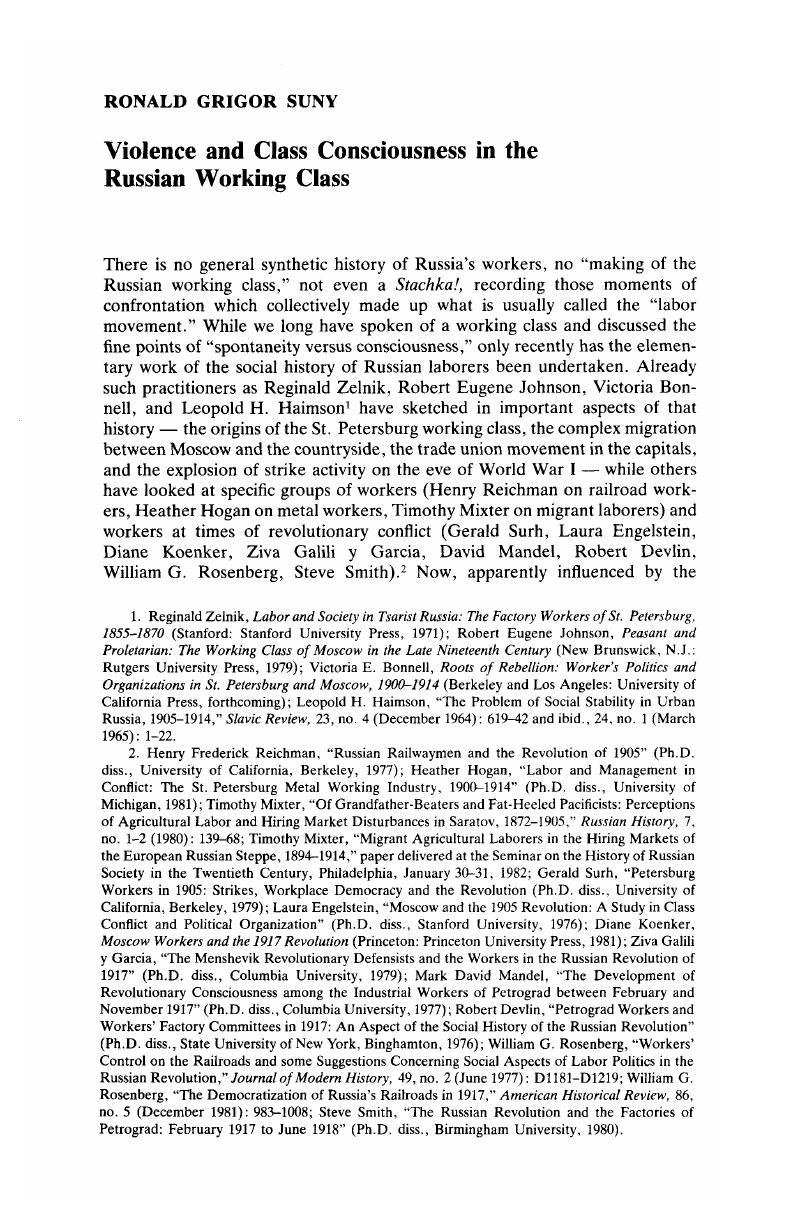Article contents
Violence and Class Consciousness in the Russian Working Class
Published online by Cambridge University Press: 27 January 2017
Abstract

Information
- Type
- Discussion
- Information
- Copyright
- Copyright © Association for Slavic, East European, and Eurasian Studies. 1982
References
1. Zelnik, Reginald, Labor and Society in Tsarist Russia: The Factory Workers of St. Petersburg, 1855-1870 (Stanford: Stanford University Press, 1971)Google Scholar; Johnson, Robert Eugene, Peasant and Proletarian: The Working Class of Moscow in the Late Nineteenth Century (New Brunswick, N.J.: Rutgers University Press, 1979)Google Scholar; Bonnell, Victoria E., Roots of Rebellion: Worker's Politics and Organizations in St. Petersburg and Moscow, 1900-1914 (Berkeley and Los Angeles: University of California Press, forthcoming);Google Scholar Haimson, Leopold H., “The Problem of Social Stability in Urban Russia, 1905-1914,” Slavic Review, 23, no. 4 (December 1964): 619–42CrossRefGoogle Scholar and ibid., 24, no. 1 (March 1965): 1-22.
2. Henry Frederick Reichman, “Russian Railwaymen and the Revolution of 1905” (Ph.D. diss., University of California, Berkeley, 1977); Heather Hogan, “Labor and Management in Conflict: The St. Petersburg Metal Working Industry, 1900-1914” (Ph.D. diss., University of Michigan, 1981); Mixter, Timothy, “Of Grandfather-Beaters and Fat-Heeled Pacificists: Perceptions of Agricultural Labor and Hiring Market Disturbances in Saratov, 1872-1905,” Russian History, 7, no. 1-2 (1980): 139–68CrossRefGoogle Scholar; Timothy Mixter, “Migrant Agricultural Laborers in the Hiring Markets of the European Russian Steppe, 1894-1914,” paper delivered at the Seminar on the History of Russian Society in the Twentieth Century, Philadelphia, January 30-31, 1982; Gerald Surh, “Petersburg Workers in 1905: Strikes, Workplace Democracy and the Revolution (Ph.D. diss., University of California, Berkeley, 1979); Laura Engelstein, “Moscow and the 1905 Revolution: A Study in Class Conflict and Political Organization” (Ph.D. diss., Stanford University, 1976); Koenker, Diane, Moscow Workers and the 1917 Revolution (Princeton: Princeton University Press, 1981)Google Scholar; Ziva Galili y Garcia, “The Menshevik Revolutionary Defensists and the Workers in the Russian Revolution of 1917” (Ph.D. diss., Columbia University, 1979); Mark David Mandel, “The Development of Revolutionary Consciousness among the Industrial Workers of Petrograd between February and November 1917” (Ph.D. diss., Columbia University, 1977); Robert Devlin, “Petrograd Workers and Workers’ Factory Committees in 1917: An Aspect of the Social History of the Russian Revolution” (Ph.D. diss., State University of New York, Binghamton, 1976); Rosenberg, William G., “Workers’ Control on the Railroads and some Suggestions Concerning Social Aspects of Labor Politics in the Russian Revolution,” Journal of Modern History, 49, no. 2 (June 1977): D1181–D1219CrossRefGoogle Scholar; Rosenberg, William G., “The Democratization of Russia's Railroads in 1917,” American Historical Review, 86, no. 5 (December 1981): 983-1008Google Scholar; Steve Smith, “The Russian Revolution and the Factories of Petrograd: February 1917 to June 1918” (Ph.D. diss., Birmingham University, 1980).
3. Hobsbawm, Eric J. and Rude, George, Captain Swing: A Social History of the Great English Agricultural Uprising of 1830 (New York: Pantheon, 1968)Google Scholar; Rude, George, “The Pre-Industrial Crowd,” in Paris and London in the Eighteenth Century (New York: Viking Press, 1973), pp. 17–34Google Scholar; Hobsbawm, E. J., “The Machine Breakers,” in Labouring Men: Studies in the History of Labour (New York: Anchor Books, 1967), pp. 7–26Google Scholar; Thompson, E. P., The Making of the English Working Class (New York: Pantheon, 1963)Google Scholar; Tilly, Charles, “Collective Violence in European Perspective,” in Violence in America: Historical and Comparative Perspectives, ed. Graham, Hugh David and Gurr, Ted Robert (New York: Signet Books, 1969), pp. 4–42.Google Scholar
4. Hobsbawm, E. J., Primitive Rebels: Studies in Archaic Forms of Social Movement in the 19th and 20th Centuries (New York: W. W. Norton & Co., 1965), p. 1.Google Scholar
5. Ibid., p. 108.
6. Ibid., p. 111.
7. Charles Tilly, “The Changing Place of Collective Violence,” in Workers in the Industrial Revolution: Recent Studies of Labor in the United States and Europe, ed. Peter N. Stearns and Daniel J. Walkowitz (New Brunswick, N.J.: Transaction Books, 1974), p. 117.
8. Ibid., p. 119.
9. E. P. Thompson, “The Moral Economy of the English Crowd in the Eighteenth Century.” Past and Present, no. 50 (February 1971), p. 78.
10. Ibid., pp. 77-78.
11. Peter N. Stearns, “National Character and European Labor History,” in Stearns and Walkowitz, Workers, pp. 16-17.
12. Johnson, Peasant and Proletarian, p. 151.
13. V. I. Lenin, Polnoe sobranie sochinenii, vol. 6 (Moscow, 1967), pp. 29-30.
14. Johnson, Peasant and Proletarian, p. 141.
15. Keep, J. L. H., The Rise of Social Democracy in Russia (Oxford: Clarendon Press, 1963)Google Scholar; Wildman, Allan K., The Making of a Workers’ Revolution: Russian Social Democracy, 1891-1903 (Chicago: University of Chicago Press, 1967)Google Scholar; Haimson, Leopold H., The Russian Marxists and the Origins of Bolshevism (Cambridge, Mass.: Harvard University Press, 1955)CrossRefGoogle Scholar; Pipes, Richard, Social Democracy and the St. Petersburg Labor Movement, 1885-1897 (Cambridge, Mass.: Harvard University Press, 1963).Google Scholar
16. Vospominaniia Ivana Vasil'evicha Babushkina, 1893-1900 gg. (Moscow, 1955); Wildman, Making of a Workers’ Revolution, pp. 112-17
17. See Wildman's dispute with Richard Pipes over the extent of Social Democratic influence in the labor movement in Wildman, Making of a Workers’ Revolution, pp. 73-74.
18. Ibid., pp. 83-88.
19. E. P. Thompson, Making of the English Working Class, pp. 9-10.
- 2
- Cited by

